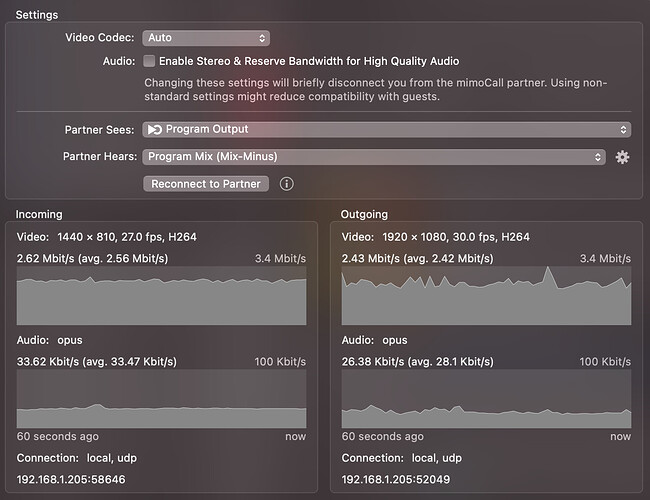Hi, My colleague and I were connecting via Mimo with her using the application and me connecting in via Mimo call. I have a 4K/1080p capable webcam and Gigabit internet, regularly running at 1000mpbs download and 300mpbs upload. Hers would be similar. The attached screenshot is from our session. She, running Mimo locally, has a good image quality, whereas mine is low quality despite having good conditions in place and looking way better on my PIP. She was running Mimolive 5.8.1 due to issues we’ve had with later versions and connecting. We really want to get higher quality footage of our interviewees/clients than what you see here on my side of the dual image. We’re wondering how to control this Mimocall quality better, as on occasion we’ve gotten great footage - see other attached sample. We sincerely welcome your thoughts as we potentially have very high profile virtual interviews coming up and are worried that the final image quality won’t satisfy our client. Thank you!
At what bitrate is your signal transported?
It seems to be that for webcams it’s FPS-based (because of motion: FPS before resolution) and for screen sharing it seems to be “quality”-oriented (resolution before FPS.
Great idea for a test. I tested myself as the host, with myself on a Mimo call in another window–both using my Logitech Brio webcam. The quality of the Mimocall is noticeably reduced. I have attached a screenshot of that - Mimocall on the right, as well as info from the hosting camera and Mimocall camera (one and the same). I also tried this same test using the built-in Facetime camera but could not get the camera to appear in the Mimocall screen as well when used as the main hosting camera. Ideas? Thank you!
Thx for the screen shots. Everything seems to be fine. And the data is looking good for h.264.
While compression/transcoding a loss in colors/quality is normal. At very bright and dark parts, details are lost. (Most of my wrinkles are affected by this, what a luck!  )
)
When I need almost broadcast quality, I use a virtual private network and NDI connections (two NDI sources inside “the same” network).
This solution is not as convenient as mimoCall, but it allows to have more bits (if the network connection allows it.)
Btw, Skype use 1.2 mbit/s (for “HD”) in average, zoom not that much, but close to it.
I will take some time to wrap my arms around the VPN with two NDI sources set up you are mentioning just so I can understand it. Is that usable for recording someone not in the same network and far away?
As for the connection I got in this case, the Mimocall info says that the Outgoing is from my computer to Mimolive, which is good on resolution and frame rate - 1920x1080, 30fps (though is there any way to go above H264?). However, the incoming from Mimolive to my computer changed to 1440x810 and 27 fps, though the Mbits/sec is greater than the Outgoing? Can you guess why the incoming would not give the full resolution and frame rate and what I might be able to do about that? Thank you so much for your incredible knowledge and generosity with your time. While I think our interviewees might like the wrinkle reduction, too, and think some clients we have coming up are going to want crisper footage, as best as we can get. Thanks again for your or anyone’s suggestions.
All depends on your project frame rate. I guess you produce in 1080p, so why should any footage have higher dimensions?
“above” is maybe a misleading term. h264 is a codec for video, which is widely used over the internet to provide relatively good footage by cheap data-cost.
With a self hosted RTMP-server you could use much more bits with h.264, and you’d have full control over the bits, but by the cost of latency and lots of more data. And troubles like dropped frames. Especially when one side is not able to provide the same or expected bandwidth. Finally, all of this is no guarantee that the final result is much better, even if the partner is able to submit a back-channel (know-how/equipment).
Sure, there are ways to have raw quality, but this needs satellite uplink and much more equipment to process the data. It would be a pity to just use a “cheap” webcam for this. (squillions of budget).
With a VPN (virtual private network) you bring in someone else into your network. Like a LAN-connection, but over the wide area network (WAN ≈ internet). Mimo would provide an NDI out (mixed minus the partner) and the partner would provide NDI cam+audio. This is great, but there are network security concerns.
Hi Elissa,
mimoCall is automatically adapting bitrates and frame rates and resolution to match what the connection can handle. This includes: The capabilities of the browser which - might not be able to encode higher resolution and bitrate - and the entire connection path between the caller and your mimoLive which can include many networks, so the “weakest link” is actually responsible for what the mimoCall transmits.
Unless you show the caller full screen, you probably do not need 1920x1080. H.264 is preferred as the Mac has hardware decoders for that format so that mimoLive is able to process more calls or other things besides the call. You can switch to VP9 in the Video Codec popup, but that causes more load on the CPU as it is encoded/decoded in software and provides only marginally better video, if at all.
Outgoing is the video that goes from your mimoLive to the caller, Incoming is what mimoLive receives from the caller which determines the video quality from the caller.
And btw, this is “zoom-quality”. This users can submit 3 to 10 fps.
I want to do some tests with them with mimoCall, but honestly I’m afraid that this by the users affected unstable situation has an effect on the whole performance inside of mimoLive.
Hi! I was out filming (in-person for a change!) all day Friday, so just getting back to this. Our use case here is probably different than most Mimolive users in that we’re doing fairly short virtual interviews via Mimolive (usually including some nice branding components like background and lower thirds not available on Zoom) and then turning those into videos. So, even if we have a “green room” with ourselves and the interviewee and client on screen at the same time, our goal is to get the best possible quality footage at 1080p when we actually do the solo interview. As these are usually pretty short, we don’t mind the extra storage of that footage, though I guess we do need to be aware of any tradeoffs in the connection quality that could be caused by recording at 1080p pro res? That nice Mimocall footage I obtained above (the one with the NCGPC burgundy logo) was obtained on a call with multiple people at once–but who were not on screen at the time–and I’m trying to figure out how to replicate it. (recorded using the ProRes 422 option)
One other consideration I’m thinking about is that in the sample with our MiniMatters team above I have the tvshow set for 30fps and am just realizing that the Brio is set for 24fps in this test, so I will try retesting after changing that.
BUT IN SUM, if you wanted to use Mimocall to record short solo or occasionally duo interviews that yield high quality footage in the end, what approach would you take within Mimo? (assume interviewees have a 1080p webcam)
Many, many thanks! And JoPhi, will visit you on YouTube.
-Elissa
Hope you had great filming experiences. 
The fall pit is to see WebCams as high quality medias.
Sensors are really tiny, so the raw material is at very low quality, even at the “good ones”. Compared to my BMD Cinema Camera 4k (used in HD), 720p compressed footage looks much better then from a 1440p WebCam in native or tinier resolution. The Micro Four Thirds sensor can capture lots of more data, which then is available for compression. Cleaner edges, smoother tones… You know this phenomenon on Youtube pre-uploaded videos. The used camera is the half rent.
So, what can you do to pick out the best of a WebCam?
- Try to increase the size of your document to 2k and downscale everything in post. This can bring a better result, when images are downscaled. (But this can bring also other side effects: more resources for render power, dithering in post…)
- Try to use another codec: ProRes has several subcodecs with more or less compression/color modes. Try 4444, colors are nearly touched.)
- Try NDI or RTMP instead of mimoCall. But this has other downsides. The interview partner has to have the know how, how to use and setup their part. You’d also have to submit a backchannel.)
Finally, none of the above ways guarantee a better final look. Tiny sensors don’t have lots of data for compression.
Johannes,
The filming on Friday was just great - we have a lot of nonprofit clients, so we get to do meaningful work around important causes. This was for a project raising awareness around Military Sexual Trauma, so pretty intense at times. But it went really well and I think the survivors I interviewed were at the point to be ready and eager to have their voices heard.
As for this conversation around how to get higher quality footage from Mimocall, thank you for sharing and teaching us so much. (which means I owe you on the English teaching! - and do plan on that) Our team has a staff meeting tomorrow, and will discuss and process everything you and Oliver have shared so far. It’s not in our realm of possibility to interject much on the interviewee side in most cases, so we’re working from that limitation. Still, we should be able to strategize a bit more based on what we are learning. Thank you so much again, and a wonderful rest of the day to you!
-Elissa






